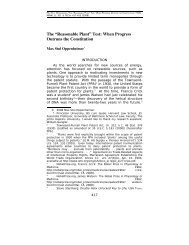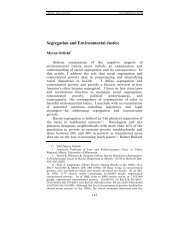An Organizational Approach to the Design of Patent Law
An Organizational Approach to the Design of Patent Law
An Organizational Approach to the Design of Patent Law
Create successful ePaper yourself
Turn your PDF publications into a flip-book with our unique Google optimized e-Paper software.
6 VERTINSKY FINAL_JAD (DO NOT DELETE) 2/27/2012 2:20 PM<br />
2012] AN ORGANIZATIONAL APPROACH 263<br />
dustry-specific and technology-specific studies and models <strong>to</strong><br />
inform proposals for a more tailored approach <strong>to</strong> patent policy.<br />
224 The effectiveness <strong>of</strong> patents in fur<strong>the</strong>ring desirable forms<br />
<strong>of</strong> economic behavior depends on a variety <strong>of</strong> fac<strong>to</strong>rs. Examples<br />
<strong>of</strong>fered by <strong>the</strong> existing patent literature, particularly NIEbased<br />
work, include differences in <strong>the</strong> levels <strong>of</strong> investment<br />
needed <strong>to</strong> develop technologies and <strong>the</strong> risks <strong>of</strong> appropriation,<br />
differences in licensing costs in different markets, 225 relative<br />
costs <strong>of</strong> increased incentives <strong>to</strong> pioneer inven<strong>to</strong>rs versus <strong>the</strong><br />
costs <strong>of</strong> impeding incremental improvers, 226 and industryspecific<br />
fac<strong>to</strong>rs that allow for patents <strong>to</strong> perform better or worse<br />
as property rights. 227 Norms can also play a role in influencing<br />
what types <strong>of</strong> collaborative practices are considered. 228<br />
The organizational approach <strong>of</strong>fers a way <strong>of</strong> incorporating<br />
<strong>the</strong>se different fac<strong>to</strong>rs in<strong>to</strong> patent policy design because it looks<br />
at <strong>the</strong> organization <strong>of</strong> innovation with <strong>the</strong> recognition that efficient<br />
organizational form will be context dependent. In moving<br />
away from a uniform patent law, however, we need <strong>to</strong> consider<br />
whe<strong>the</strong>r selection between paths <strong>of</strong> innovation is an appropriate<br />
domain for patent lawmakers. As North reminds us, institutions<br />
are inherently imperfect. They are subject <strong>to</strong> <strong>the</strong> ideas,<br />
ideologies, and interests <strong>of</strong> those who govern. How much government<br />
intervention do we want in selecting for or against alternative<br />
forms <strong>of</strong> innovation? Decisions about <strong>the</strong> nature <strong>of</strong><br />
<strong>the</strong> tailoring must also be made in light <strong>of</strong> <strong>the</strong> costs <strong>of</strong> administering<br />
such detailed rules and <strong>the</strong> limitations <strong>of</strong> both decisionmakers<br />
and implementers <strong>of</strong> <strong>the</strong> rules. A slightly different but<br />
equally important policy implication is that <strong>the</strong> government is,<br />
whe<strong>the</strong>r directly or indirectly, selecting for or against certain<br />
kinds <strong>of</strong> innovation through patent policy. 229 In certain coun-<br />
224. See, e.g., Hall & Ziedonis, supra note 222, at 101; Peter Lee, Towards<br />
a Distributive Commons in <strong>Patent</strong> <strong>Law</strong>, 2009 WIS. L. REV. 917, 924–25; Fiona<br />
Murray, The Stem Cell Market: <strong>Patent</strong>s and <strong>the</strong> Pursuit <strong>of</strong> Scientific Progress,<br />
356 NEW ENG. J. MED. 2341, 2343 (2007).<br />
225. See, e.g., Gallini & Scotchmer, supra note 120, at 62–65 (arguing that<br />
<strong>the</strong> ideal design <strong>of</strong> an intellectual property system depends on <strong>the</strong> ease with<br />
which rights holders can enter in<strong>to</strong> licensing and o<strong>the</strong>r contractual arrangements<br />
involving <strong>the</strong>se rights).<br />
226. See id. at 68.<br />
227. See BESSEN & MEURER, supra note 22, at 91–94.<br />
228. See, e.g., Jay P. Kesan, Transferring Innovation, 77 FORDHAM L. REV.<br />
2169, 2169 (2009) (discussing <strong>the</strong> focus <strong>of</strong> universities on narrow licensing<br />
practices and <strong>the</strong> need <strong>to</strong> explore broader forms <strong>of</strong> collaboration in <strong>the</strong>ir technology<br />
transfer practices).<br />
229. See, e.g., Bessen, supra note 221, at 26–32. See also Rebecca S. Eisen-






